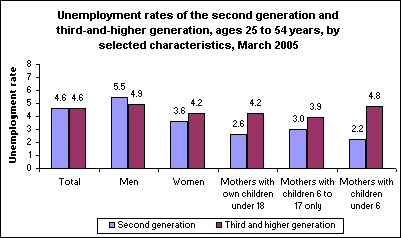October 13, 2006 (The Editor’s Desk is updated each business day.)
Unemployment of second- and third-and-higher-generation Americans
Overall, the unemployment rate for members of the second generation aged 25 to 54 years is the same as that for the same age group in the third
and higher generations.

[Chart data—TXT]
The jobless rate among second-generation men is higher than that for their third-generation-and-higher counterparts; among women, the unemployment rate for those in the second generation is lower than that for those in the third
and higher generations.
The unemployment rate of second-generation mothers with children under age 18 was 2.6 percent in March 2005, compared with 4.2 percent for the third
and higher generations. Second-generation mothers with children under 6 years of age were also less likely to be unemployed than
their third-generation-and-higher counterparts.
Second-generation Americans are defined as native-born Americans who have either one parent or both parents who are foreign born. Americans of
the third and higher generations are native-born Americans whose parents are both native born.
These data are from the Annual Social and Economic Supplement (ASEC) to the Current Population
Survey. Find out more in "Labor force characteristics of second-generation
Americans," by Abraham Mosisa, Monthly Labor Review, September 2006.
Related TED article:
Of interest
Spotlight on Statistics: National Hispanic Heritage Month
In this Spotlight, we take a look at the Hispanic labor force—including labor force participation, employment and unemployment, educational attainment, geographic location, country of birth, earnings, consumer expenditures, time use, workplace injuries, and employment projections.
.
Read more »
